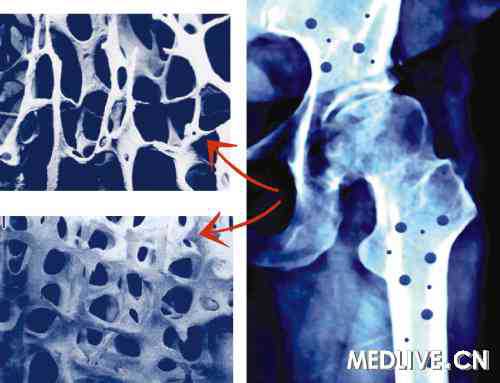专家视点——有关骨质疏松症医疗过失案例分析
2012-06-17 不详 网络
作者:夏威夷大学名誉教授S. Y. TAN博士。 提问:1名60岁绝经后妇女因类风湿性关节炎接受强的松治疗,每日2.5 mg。6个月后,患者出现腰背疼痛,经检查发现L4椎体骨折。之前医生没有提醒其类固醇可能导致骨质疏松症,也没有建议其补充钙、维生素D或使用双膦酸盐类药物。患者以医疗过失起诉,以下哪种说法最好? A. 骨质疏松症并不是糖皮质激素治疗的常见并发症,因此没有必要提醒患者这一风险。 B.
作者:夏威夷大学名誉教授S. Y. TAN博士。
提问:1名60岁绝经后妇女因类风湿性关节炎接受强的松治疗,每日2.5 mg。6个月后,患者出现腰背疼痛,经检查发现L4椎体骨折。之前医生没有提醒其类固醇可能导致骨质疏松症,也没有建议其补充钙、维生素D或使用双膦酸盐类药物。患者以医疗过失起诉,以下哪种说法最好?
A. 骨质疏松症并不是糖皮质激素治疗的常见并发症,因此没有必要提醒患者这一风险。
B. 糖皮质激素诱导骨质疏松症的发生率可以通过减少剂量和(或)缩短治疗时间来降低,而非加用双膦酸盐类药物。
C. 患者要想打赢这场官司必须证明,目前的标准做法就是应该采用双膦酸盐类药物治疗所有的骨质疏松症妇女。
D. 建议医生在辩护时证明椎体骨折是由绝经后骨质疏松症或者类风湿性关节炎造成的,而非强的松,毕竟患者的类固醇用药剂量并没有过量,暴露时间也比较短。
E. 如果患者使用了阿仑膦酸盐后出现了下颌骨坏死,她还是会找到理由起诉医生,无论医生是否告知过其这一风险。
答案:D。骨质疏松性骨折引发的医疗纠纷案件多得惊人,医生可能因漏诊、没有提醒或者治疗失败而遭到起诉。绝经后妇女的风险最高,但该病也可能累及男性以及某些患者人群,比如类风湿性关节炎或性腺功能减退患者、或者长期服用糖皮质激素的患者。药理剂量的类固醇也可能导致骨丢失和骨折,并且可能加重或导致其他严重并发症,比如无菌性坏死、糖尿病、高血压和白内障。
类固醇剂量越大(相当于超过每日5~10 mg强的松),用药时间越长(超过3~6个月),骨折风险就越高。近期研究表明,在口服钙剂和维生素D的基础上加用双膦酸盐类药物可显著降低这一风险,因此建议需要长期接受类固醇治疗的患者使用这类药物。
在上述假设中,原告不需要证明目前的标准做法是所有存在骨质疏松症风险的妇女都应该接受双膦酸盐类药物治疗,而是只有接受了类固醇治疗的患者需要使用双膦酸盐类药物。但是,这名患者所用类固醇的剂量较小,而且患者本身还存在其他的危险因素。因此,医生可以抓住这一点来进行辩护。
在1989年华盛顿特区的Weil与Seltzer案件中,Seltzer医生采用类固醇对患者Weil进行治疗长达20多年,并且告知患者这是一种抗组胺药物。后来患者出现了类固醇并发症,包括血压改变、感染、髋关节和椎体骨折。患者在54岁时因骑跨栓塞猝死,栓子中含有骨髓碎片,被认为是来自骨质疏松的骨骼。Seltzer医生在1980~1984年开具的可的松处方多达130万片。被告方从共同疏忽、风险承担、介入原因等方面进行辩护,但未能成功。
在2001年俄勒冈州的Fuller与Merten案件中,患者因关节炎接受类固醇治疗后出现了颈椎骨质疏松,并在一次交通事故后颈椎骨折。法庭考虑到侵权行为人存在过失并且对受害人造成了伤害,因此针对这一严重损伤采用了“蛋壳脑袋(eggshell skull)”法则(编者按:指通常不会对正常人造成伤害的打击却会造成某人的致命损害。为确定责任,保护受害人,应认为行为与损害之间存在因果关系并且加害人有"过失")。
还有另外一起案例,1名对含石油溶剂过敏的机械工人出现了重度接触性皮炎,需要采用促肾上腺皮质激素胃肠外治疗、康宁乐(曲安奈德)并口服类固醇长达20多年。患者因出现了白内障和骨质疏松症而起诉医生和生产商。但由于患者没有找到专家证人来证明医生采用的并非标准治疗或者产品警示标签信息不足而败诉。
最令人关注的骨质疏松症案件很可能是Warren 与Schecter一案,原告因其外科医生没能指出骨质疏松症的远期风险而胜诉,获得了960万美元的赔偿金。这名外科医生不认为骨质疏松症、骨软化症和骨骼疼痛是消化性溃疡手术的潜在风险,因此没有与患者讨论这些风险。原告在法庭上指出,如果医生当时提醒她可能存在代谢性骨病的风险,那么她肯定不会同意手术。该患者在出现了术后倾倒综合征和碱性反流性胃炎后接受了二次手术,第二次手术时这名外科医生也没有告知其手术可能增加代谢性骨病风险。后来患者出现了重度骨质疏松性骨折,依照知情同意法则,原告打赢了这场医疗官司。
医生有义务提醒患者其所用药物的副作用。所有药物都可能产生严重的不良反应,抗骨质疏松症药物也不例外。一种与双膦酸盐类药物相关的罕见但严重并发症为下颌骨坏死。这种并发症特别容易出现在那些在双膦酸盐类药物治疗期间接受牙科手术或者因恶性肿瘤等基础疾病而接受头颈部放疗的患者身上。预计包括共同起诉在内的案件不仅会针对药品生产商,医生方面由于缺少知情同意程序或者没有提醒也可能面临起诉。同样,医生还应该告知患者近来提出的据说与阿仑膦酸盐类药物相关的非典型性股骨骨折风险。
最后,我们应该意识到,如今越来越多的证据表明对绝经后骨质疏松症进行治疗可以显著降低患者骨折的风险。髋关节骨折是一种非常严重的致残性疾病,尤其是对于老年人,因此没能诊断并治疗骨质疏松症可能会构成医疗过失,从而需要承担相应的法律责任。
这篇文章只是一份教育材料,并不代表作者有关医学、伦理学或法律方面的建议。此文摘自作者所著《医疗过失:了解法律,控制风险(Medical Malpractice: Understanding the Law, Managing the Risk)》(2006)一书。要了解更多信息,请联系作者:siang@hawaii.edu。
S. Y. TAN, M.D., J.D.
Elsevier Global Medical News
Question: A 60-year-old postmenopausal woman was placed on 2.5 mg of prednisone daily for rheumatoid arthritis. Six months later, she developed back pain and was found to have an L4 vertebral fracture. She had not been warned that steroids could cause osteoporosis, and was not placed on supplemental calcium, vitamin D, or a bisphosphonate. In a lawsuit for negligence, which of the following is best?
A. Osteoporosis is an uncommon complication of glucocorticoid therapy, so there is no need to warn of this complication.
B. The incidence of glucocorticoid-induced osteoporosis can be reduced by decreasing the dose and/or duration of therapy, but not by adding a bisphosphonate.
C. To prevail in her lawsuit, the patient must show that it is the standard of care to use a bisphosphonate to treat all osteoporotic women.
D. The doctor’s defense may be to show that the vertebral fracture was caused by postmenopausal osteoporosis or rheumatoid arthritis rather than prednisone, as her steroid dose was not excessive and the period of exposure relatively short.
E. If she had been given alendronate and developed osteonecrosis of the jaw, she would have a cause of action against the doctor irrespective of whether she had been informed of this risk.
Answer: D. Osteoporotic fractures are a surprisingly common malpractice issue, with cases arising from failure to diagnose, warn, or treat. Postmenopausal women are at particular risk, but the condition can also affect men and certain patient groups such as those with rheumatoid arthritis or hypogonadism, or those taking long-term glucocorticoids. Pharmacologic doses of steroids can lead to bone loss and fractures, and can aggravate or cause other serious complications such as aseptic necrosis, diabetes, hypertension, and cataracts.
Fracture risk rises with increasingly higher steroid doses (equivalent of greater than 5-10 mg of prednisone daily) and duration of therapy (greater than 3-6 months). Recent studies indicate that a bisphosphonate added to oral calcium and vitamin D can significantly attenuate this risk, and its use has therefore been recommended in patients requiring long-term steroids.
In the above hypothetical, the plaintiff need not prove that it is the standard practice to treat all women at risk of osteoporosis with a bisphosphonate, just those on steroids. However, she received a relatively low dose, and there are other risk factors in her case. As a result, her doctor may be able to mount a defense.
In Weil v. Seltzer, a 1989 Washington, D.C., decision, Dr. Seltzer treated his patient, Dr. Weil, for more than 20 years with steroids, telling the patient that it was an antihistamine. The patient developed steroid complications, including blood pressure changes, infections, and hip and vertebral fractures. He died suddenly at age 54 from a saddle block embolism, which contained bone marrow fragments believed to have arisen from osteoporotic bone. Dr. Seltzer had ordered 1.3 million tablets of cortisone from 1980 to 1984. The defense raised legal arguments of contributory negligence, assumption of risk, and intervening cause, but was unsuccessful.
In Fuller v. Merten, a 2001 Oregon case, a patient taking steroids for arthritis developed osteoporosis of the cervical spine, which fractured after an automobile accident. The court applied the “eggshell skull” rule for the serious injuries as the tortfeasor “takes the victim as he finds him.”
In yet another case, a mechanic who was allergic to petroleum-based solvents developed severe contact dermatitis and required parenteral treatment for more than 20 years with adrenocorticotropic hormone, Kenalog, and oral steroids. He developed cataracts and osteoporosis, but lost the lawsuit against the doctor and the manufacturer because he did not have expert witnesses to testify to the standard of care and adequacy of the warning label.
The most dramatic osteoporosis case is probably Warren v. Schecter, where the plaintiff won a $9.6 million judgment against her surgeon for his failure to disclose a remote risk of osteoporosis. Her surgeon did not believe osteoporosis, osteomalacia, and bone pain were risks of peptic ulcer surgery, and so did not discuss those risks with her. The plaintiff testified at trial that had the doctor warned her of the risk of metabolic bone disease, she would not have consented to surgery. A second operation was undertaken after she developed postop dumping syndrome and alkaline reflux gastritis, and the surgeon again failed to advise her of the risk of metabolic bone disease. The plaintiff subsequently developed severe osteoporotic fractures, and won a malpractice lawsuit under an informed consent theory.
A physician is obligated to warn patients of the side effects of a prescribed drug. All drugs can have serious adverse effects, and anti-osteoporosis drugs are no exception. A rare but serious complication associated with bisphosphonates is osteonecrosis of the jaw. This complication is particularly apt to occur in bisphosphonate-treated patients undergoing dental procedures or in those with an underlying malignancy who had received radiation to the head and neck. Predictably, lawsuits including class-action suits have targeted the drug manufacturers, but physicians may also be roped in on the basis of lack of informed consent and failure to warn. Similarly, doctors would do well to inform patients of the more recent concern over atypical femur fractures allegedly linked to alendronate.
Finally, it is important to recognize the compelling evidence showing that treating postmenopausal osteoporosis can significantly reduce fracture risk. Fracture of the hip is a very serious disability, especially in the elderly, so the failure to diagnose and treat osteoporosis may amount to a negligent omission – with implications for legal liability.
本网站所有内容来源注明为“梅斯医学”或“MedSci原创”的文字、图片和音视频资料,版权均属于梅斯医学所有。非经授权,任何媒体、网站或个人不得转载,授权转载时须注明来源为“梅斯医学”。其它来源的文章系转载文章,或“梅斯号”自媒体发布的文章,仅系出于传递更多信息之目的,本站仅负责审核内容合规,其内容不代表本站立场,本站不负责内容的准确性和版权。如果存在侵权、或不希望被转载的媒体或个人可与我们联系,我们将立即进行删除处理。
在此留言









#案例分析#
42
#骨质#
35